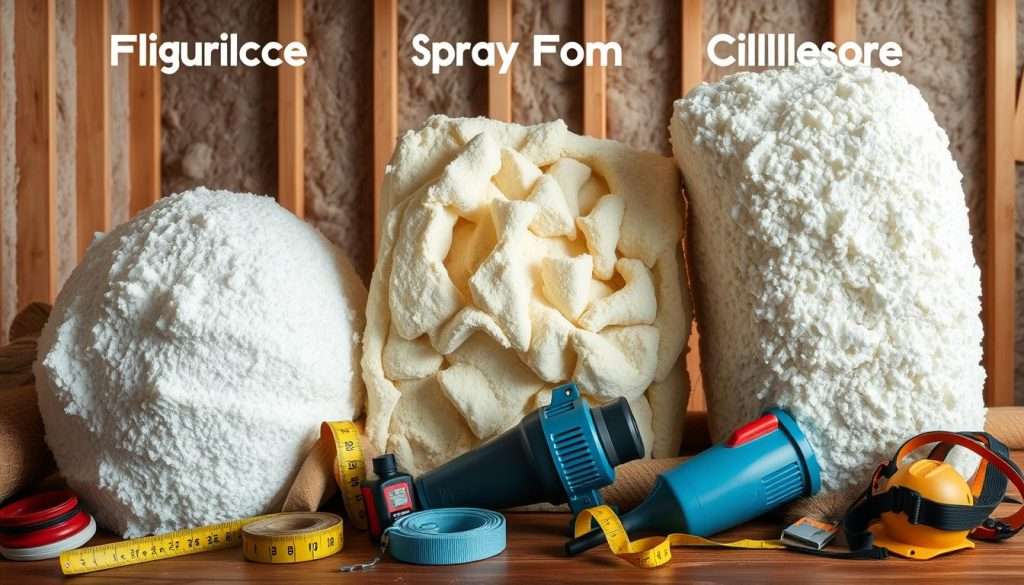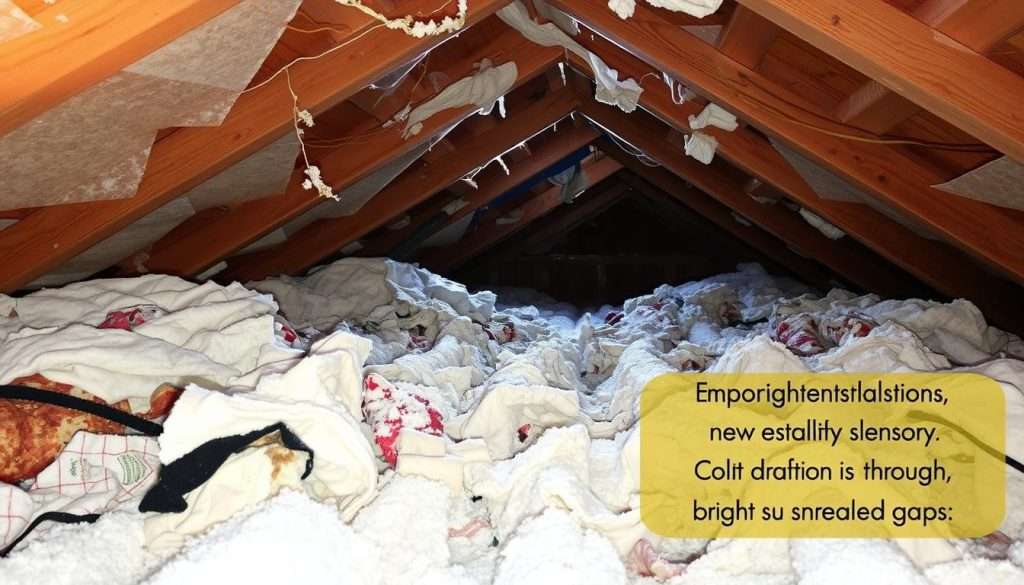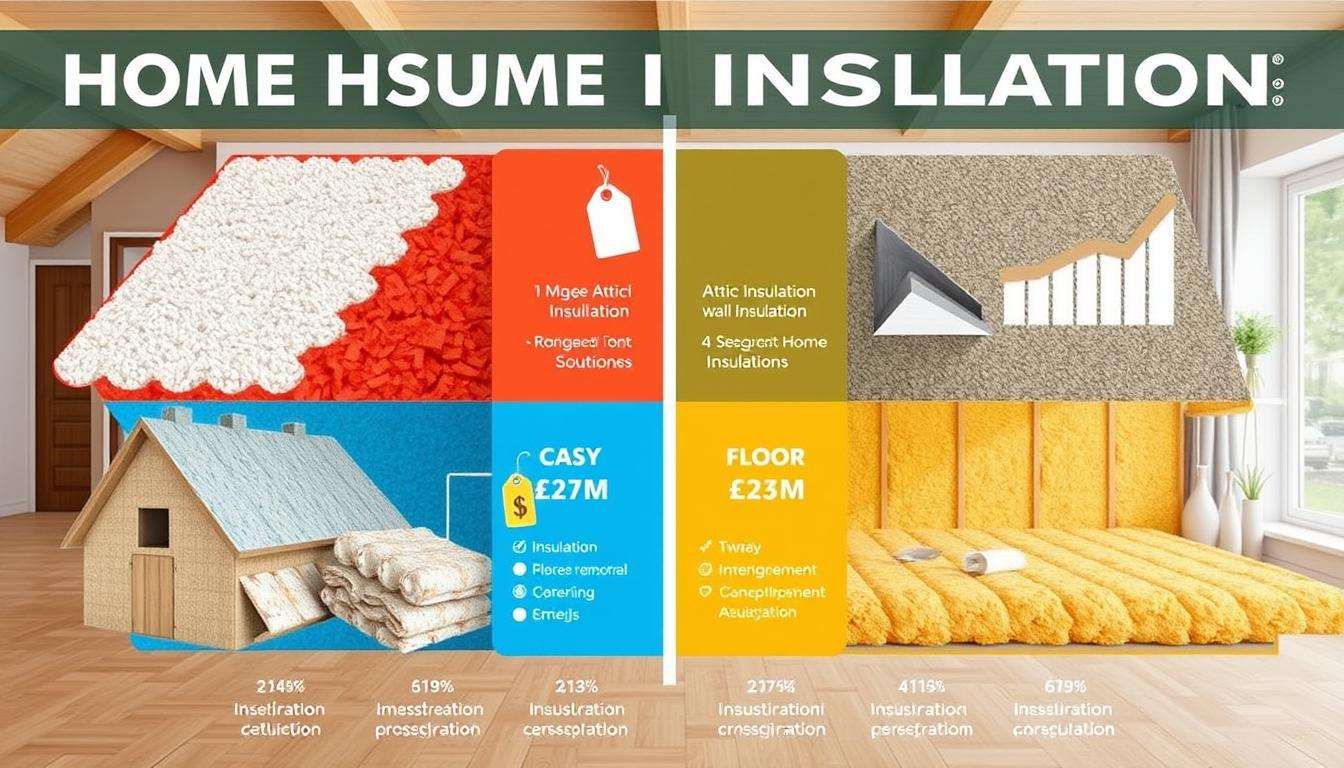Knowing home insulation costs is key for homeowners and DIY fans. There are many insulation types and factors that affect insulation installation prices. This knowledge helps you save money and stay cozy.
The cost of insulating a house is between $1,600 to $8,000. This depends on the materials and how big the area is.
Prices for insulation can change a lot. They go from $0.80 to $4.50 per square foot. This shows how the quality of materials and how hard it is to install can change prices.
Learning about insulation helps you make your home more energy-efficient. It also helps you keep costs down.
In this guide, we want to help you. We’ll share info on different insulation types. This will prepare you for your home insulation project.
Key Takeaways
- The average insulation cost for a house ranges between $1,600 to $8,000.
- Insulation installation prices vary based on materials and project complexity.
- Understanding R-values is crucial for effective insulation.
- Cellulose is often a cost-effective and efficient insulation option.
- Professional installation may save time and provide better results in many cases.
Understanding Insulation Types and Their Costs
Home insulation comes in many types, each with its own cost. Materials, installation, and location affect these prices. Let’s look at three common types and their prices.
Fiberglass Insulation
Fiberglass is a popular choice. It’s available in batts and rolls. Prices are $0.40 to $1.00 per square foot, based on thickness and complexity.
For best results, hiring a pro is often needed, especially for big areas.
Foam Board Insulation
Foam board is great for walls, floors, and ceilings. It costs $1.50 to $3.00 per square foot. It’s known for its high thermal resistance, making it perfect for new builds and updates.
Spray Foam Insulation
Spray foam is top-notch for keeping warmth in. Prices range from $0.50 to $2.50 per board foot. It’s great for hard spots, offering flexibility.
Factors Affecting Insulation Cost
Homeowners need to know several things when looking at insulation prices. These factors can change how much you pay for insulation.
Materials Quality
The quality of materials is key in insulation cost. You can choose from fiberglass, cellulose, foam, and mineral wool. Each has its own price:
- Fiberglass insulation costs between $0.50 and $1.50 per square foot.
- Blown-in insulation, like cellulose or fiberglass, is $1 to $2 per square foot.
- Spray foam insulation is $1 to $4 per square foot.
Higher quality materials cost more but last longer and work better. The R-value, which shows how well it keeps heat out, can also raise prices. Homes in cold places need higher R-values, which means higher costs.
Installation Complexity
How hard it is to install insulation also affects the price. Professional methods, like spray foam or blown-in cellulose, cost more than doing it yourself. Things like:
- Building size and layout
- Age of the structure
- Need for special techniques in older homes
can make installation harder and more expensive. Bigger or more complex buildings need more materials and time. It’s important to think about these costs when choosing how to install insulation.
Regional Price Variations
Where you live can also change insulation costs. Materials shipped far away cost more because of shipping. Some areas might have limited supply, making prices go up. Things like:
- Local labor rates
- Market demand for insulation
- State energy efficiency requirements
all affect the final price. Knowing these differences helps you plan your budget better.
| Insulation Type | Cost per Square Foot |
|---|---|
| Fiberglass | $0.50 – $1.50 |
| Blown-in (Cellulose/Fiberglass) | $1.00 – $2.00 |
| Spray Foam | $1.00 – $4.00 |
Average Cost of Home Insulation
Knowing the average cost of home insulation is key for homeowners. Different insulation types have different prices. We’ll help you find the best option for your home.
Price Ranges for Different Insulation Types
It’s important to look at various insulation types and their costs. Here are some prices for popular materials:
| Insulation Type | Cost per Square Foot |
|---|---|
| Cellulose (attic) | $2.30 |
| Cellulose (cathedral ceiling) | $3.50 – $5.00 |
| Cellulose (basement) | $1.50 – $4.00 |
| Spray foam (open cell, 3”) | $1.35 – $1.95 |
| Spray foam (closed cell, 3”) | $3.00 – $4.50 |
| Fiberglass (loose fill) | $0.30 – $1.30 |
| Fiberglass (batt) | $0.30 – $1.30 |
| Radiant barriers | $0.70 – $0.90 |
Cost per Square Foot Comparisons
Comparing costs per square foot can help you plan. Here’s a quick look at some common insulation types:
- Blown-in insulation cost for cellulose is about $2.30. Fiberglass costs between $0.30 and $1.30.
- Attics or cathedral ceilings have prices from $3.50 to $5.00.
- Foam board insulation costs $0.50 to $0.75 per board foot.
Good insulation saves money in the long run. Insulating a 2,000 square foot home costs $3,500 to $8,750. This shows the importance of budgeting.
DIY vs. Professional Installation Costs
Choosing between DIY insulation and hiring pros affects your budget and insulation quality. Knowing the tools, materials, and long-term benefits helps you choose wisely for your home.
Tools and Materials for DIY Projects
DIY insulation needs various tools and materials. Here’s what you might need:
- Blowing machine rental: About $100 a day for blown-in insulation
- Cellulose insulation bags: Costs around $15 for a 25-pound bag
- Fiberglass batt insulation: Costs $150 to $700 for 500 square feet
DIY attic insulation costs about $500 or less. This is cheaper than professional costs, which can be $1,000 to $2,400 for the same work.
Benefits of Hiring Professionals
Hiring pros has its own benefits, even if it costs more:
- Speed and efficiency: Pros work faster, less disruption to your life.
- Expertise: Insulation contractors find and fix air leaks and moisture that DIY might miss.
- Warranty: Pros offer a warranty for materials and labor, giving you peace of mind.
- Safety: Pros know how to handle insulation safely, reducing risks.
- Code compliance: Pros make sure the job meets local building codes, avoiding fines.
Even though pros cost more upfront, the savings on heating and cooling, insurance, and their expertise make it worth it.
Energy Efficiency Savings from Insulation
Insulation makes your home more comfortable and saves money on energy bills. Many people don’t know how much they can save. A well-insulated home can really cut down on your utility bills.
Impact on Utility Bills
Adding insulation and sealing air leaks can save 10% to 45% on energy costs. Sadly, about 90% of U.S. homes don’t have enough insulation. This is a big chance to save money.
For example, sealing air leaks and adding insulation can save up to $165 a month. That’s almost $2,000 a year for a household spending $300 on electricity.
Most homes lose 40% of their heating and cooling energy through air leaks. Fixing these leaks can save 15% on heating and cooling costs. This helps a lot with your utility bills. The EPA’s estimates show how important these improvements are.
Long-term Cost Benefits
Insulation is a smart investment for the long run. The cost of insulation can be paid back quickly through energy savings. Fiberglass attic insulation can even increase your home’s value by up to 117%.
Homeowners might also get tax credits up to $500 for energy-saving upgrades. This makes insulation projects even more attractive financially.
Comparing Insulation Companies
Choosing the right insulation company is key to a more energy-efficient home. There are many insulation companies out there. We can make comparing them easier by looking at a few important criteria.
Criteria for Selecting a Provider
Here are some important factors to consider when comparing insulation providers:
- Experience and Expertise: Find companies with a good track record in insulation, especially the type you need.
- Reputation: Check out customer reviews to see how good their service and products are.
- Warranty and Guarantees: Pick companies with strong warranties for materials and labor. This gives you peace of mind.
- Pricing Transparency: Look for companies that give clear estimates. This way, you know exactly what you’re paying for.
- Variety of Options: Choose companies that offer different insulation types. This lets you compare costs and benefits.
Top Insulation Companies by Reputation
Some insulation companies are known for their good reputation and happy customers:
| Company Name | Type of Insulation Offered | Customer Rating |
|---|---|---|
| Owens Corning | Fiberglass Batts & Blown-In Insulation | 4.5/5 |
| Johns Manville | Fiberglass & Foam Insulation | 4.3/5 |
| Icynene-Lapolla | Closed-Cell & Open-Cell Spray Foam Insulation | 4.6/5 |
| Rockwool | Mineral Wool & Fiberglass Insulation | 4.4/5 |

In summary, taking your time to evaluate these aspects when comparing insulation providers will lead to a more energy-efficient home. It may also increase your property value in the long run.
Government Incentives and Rebates
Homeowners can save money on insulation costs with government help. Knowing about these programs can help you save money. It also makes your home more energy-efficient.
Tax Credits for Energy-Efficient Upgrades
Tax credits help homeowners save money on upgrades. You can get these credits for improvements made after January 1, 2023, until 2032. The credit is 30% of the cost, making upgrades more affordable.
- Maximum annual credit of $1,200 applies to energy-efficient property costs.
- Up to $2,000 per year is available for heat pumps, water heaters, biomass stoves, and boilers.
- No lifetime limit exists on the credit; however, annual claims are allowed until 2033.
- Restrictions apply to certain expenditures, including windows, doors, and home energy audits.
To get these tax credits, your home must be an existing one. It also needs to be your primary residence in the U.S. You can claim credits for many items, like insulation, within certain limits.
Local Programs and Grants
Local programs and grants also help homeowners. Many states and cities offer money to help with energy-saving upgrades. These programs often focus on insulation, helping you save even more.
| Program Type | Description | Potential Savings |
|---|---|---|
| State Grants | Financial aid for energy-efficient home improvements | Varies by state |
| Utility Rebates | Incentives offered by utility companies for reducing energy consumption | Up to $500 |
| Local Tax Incentives | Reductions in property taxes for energy-efficient upgrades | Varies by jurisdiction |
Check if you qualify for both federal and local incentives. Using these resources can lower insulation costs. It makes your home more comfortable and helps the environment.
Seasonal Considerations for Insulation
When to insulate your home is key for saving money and keeping it cozy. Knowing when to insulate can help you save a lot. The best times to insulate change with the weather and prices, affecting your comfort and bills.
Best Times for Insulation Installation
Insulating at the right time can save you a lot of money. Here are some tips for the best times:
- Late spring to early summer often sees lower labor costs. Many contractors are eager for work, resulting in potential discounts.
- Fall months can be optimal for insulating before winter kicks in. This timing enhances the effectiveness of insulation, keeping homes warm and reducing heating costs.
- Mid-winter may have higher seasonal insulation costs due to increased demand. However, addressing insulation issues during this time can prevent heating losses and enhance energy efficiency.
Impact of Seasonal Changes on Costs
Seasonal changes affect insulation costs a lot. Here are some important points:
| Season | Potential Cost Impact | Recommended Actions |
|---|---|---|
| Spring | Lower labor rates; fewer projects | Schedule inspections and plan installations |
| Summer | Moderate costs; demand usually increases | Consider insulation installation during cooler days |
| Fall | Prices start to rise; preparation for winter | Prioritize attic insulation and sealing |
| Winter | Highest costs due to urgent needs | Focus on emergency repairs and immediate solutions |
Proper attic insulation can save up to 20% on heating costs in cold months. Sealing gaps and insulating pipes can save about 10% more. Knowing these seasonal tips helps you insulate wisely.
Common Insulation Mistakes to Avoid
Insulating your home right can save you money and make it more energy-efficient. Here are some key things to remember when you start your insulation project:
Over-Insulating Your Home
Getting the right amount of insulation is very important. Too much fiberglass insulation can make it less effective. This is because it squishes the air pockets that help keep your home warm or cool.
Use the right amount of insulation for your area. Using insulation with a low R-value might seem good at first. But it can actually make your fuel costs go up and ruin any savings from insulation.
Forgetting Air Sealing
Many people forget to seal air properly when insulating. This lets air move between spaces, which defeats the purpose of insulation. Make sure to seal all gaps and cracks well.
Or else, you might get drafts that raise your energy bills. Also, covering roof vents to save on heating can make your air conditioning cost go up in summer. It’s important to keep air moving in your home for health and comfort.

Additional Costs to Consider
When you plan an insulation project, remember there are costs beyond the basic ones. Hidden fees can change your budget a lot. Knowing about permits, inspections, and removing old insulation helps you budget better.
Permitting and Inspection Fees
Many places need permits for insulation to follow local rules. These permits cost different amounts. Fees can be from $50 to $500, based on the project’s size.
To not spend extra money, check local rules before you start.
Removal of Old Insulation
If your home has old insulation, you need to remove it first. This adds to your costs. The price to remove insulation changes based on the type.
| Type of Insulation | Removal Cost per Sq Ft |
|---|---|
| Fiberglass | $0.50 – $1.50 |
| Cellulose | $1 – $2 |
| Spray Foam | $1.50 – $3 |
Removing old insulation is key for new insulation to work well. It helps save energy. Thinking about these costs helps you plan your budget well.
Tips for Budgeting Your Insulation Project
Planning your insulation project needs a good budget. First, know the costs for materials and labor. Insulation can cost a lot, depending on what you choose.
Think about what you need. Do you want the best insulation or something less expensive? Save extra money in a special account to stay on budget.
Creating a Comprehensive Budget
A good budget helps you plan better. Start with costs for materials and installation. You might need to pay for ventilation too.
Look into financing options like loans or energy programs. They can help with the cost. Good insulation saves money and makes your home more valuable.
Finding Affordable Financing Options
Don’t forget about financing that can help with costs. Government incentives and rebates can make a big difference. Check for tax credits for energy upgrades.
Get quotes from different insulation companies. This can help you find the best price. Saving money now means a cozier home later.
